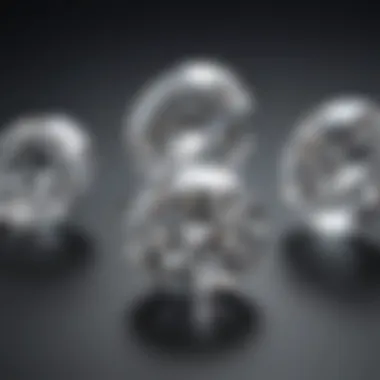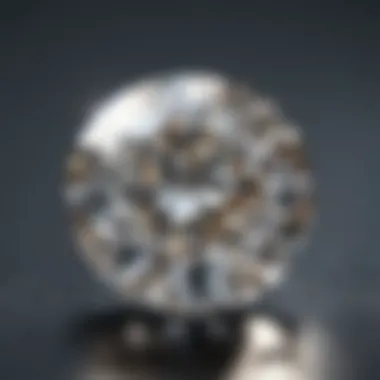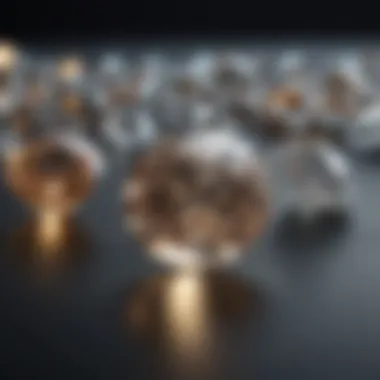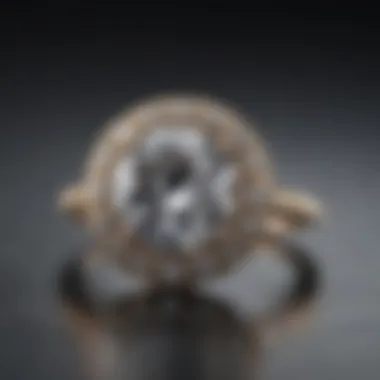Understanding 1 Carat Moissanite Size in Millimeters


Intro
In the realm of gemstones, moissanite has emerged as a significant contender, especially in the jewelry market. Understanding its size, specifically a 1 carat moissanite, is crucial for anyone involved in jewelry selection or design. It is not just about the aesthetic appeal but also about the tangible measurements that influence purchasing decisions.
Knowing how carat weight correlates to actual dimensions is vital. The clarity of this relationship aids consumers in making more educated choices. Additionally, this piece contrasts moissanite with traditional diamonds, shedding light on their size differences and offering practical guidance for choosing the right gemstone. This exploration will ultimately enhance the knowledge of gemstone enthusiasts, collectors, and jewelry designers.
Gemstone Overview
Definition of Gemstones
Gemstones are naturally occurring minerals or organic materials valued for their beauty and rarity. In the case of moissanite, it is a silicon carbide compound that was first discovered in a meteorite crater. With its remarkable brilliance and durability, moissanite has gained popularity as an alternative to diamonds in fine jewelry.
Classification of Gemstones
Gemstones can be broadly classified into two categories: precious and semi-precious. While diamonds belong to the precious category, moissanite is often regarded as semi-precious. Here are some key features that distinguish gemstones:
- Hardness: Measured by the Mohs scale, moissanite has a hardness of 9.25, making it suitable for daily wear.
- Brilliance: Moissanite exhibits more fire and brilliance than traditional diamonds, enhancing its appeal.
- Color: Natural moissanite may come in various hues, though colorless versions are most sought after for jewelry.
Moissanite's rising popularity reflects consumer preference for both beauty and value. As such, understanding its attributes and dimensions is essential for those engaging with this captivating stone.
"Moissanite often shares similar dimensions to diamonds, provoking curiosity in those interested in quality and appearance when selecting gemstones."
Understanding the nuances of carat weight and how it translates to physical size not only assists in personal preference but also influences broader design considerations.
Foreword to Moissanite
Moissanite has gained significant attention in recent years as a popular alternative to diamonds. Its unique properties and aesthetic appeal make it an intriguing choice for both consumers and jewelry designers. Understanding moissanite is essential for anyone looking to make informed decisions about gemstone purchases.
The focus on moissanite encompasses various elements. Firstly, its origin is rooted in a fascinating discovery. Secondly, the properties of moissanite differentiate it from traditional gemstones, providing a deeper appreciation of its value. In this section, we will explore these aspects, shedding light on why understanding moissanite’s attributes is crucial for enthusiasts.
Origin and Discovery of Moissanite
Moissanite was first discovered in 1893 by the French chemist Henri Moissan. He found the mineral in a meteorite crater in Arizona. Initially mistaken for diamond, this mineral turned out to be silicon carbide. Its rarity in nature led to a synthetic version being created in the laboratory in the late 20th century. This development opened doors for widespread use in jewelry, enabling more consumers to access beautiful stones without the associated ethical concerns of diamond mining.
The significant breakthrough in creating synthetic moissanite not just increased its availability but also enhanced its appeal. The process ensures the resulting stones are both ethical and sustainable. This origin story adds layers to the appreciation of moissanite, marking it not just as a jewel but a product of scientific innovation.
Properties of Moissanite
Moissanite possesses a set of properties that make it distinct from other gemstones, most notably diamonds. Foremost among these is its brilliance. Moissanite has a higher refractive index than diamond, which means it can exhibit more sparkle and fire. This characteristic is often one of the key reasons consumers choose moissanite over other options.
Furthermore, moissanite is exceptionally durable. With a hardness rating of 9.25 on the Mohs scale, it is highly resistant to scratching and everyday wear. This durability makes it an excellent choice for jewelry that is worn daily, such as engagement rings.
In addition to brilliance and durability, different colors can be found in moissanite stones. The most common are colorless, but they can also be found in shades of yellow and green. This variety allows buyers to select according to personal taste and style preferences.
"Understanding moissanite's unique properties helps consumers appreciate its value and make informed jewelry choices."
Given these properties, it’s essential for both potential buyers and enthusiasts to recognize moissanite's place in the gemstones market. By comprehending these elements, consumers can engage with moissanite more meaningfully, elevating their choices in the realm of fine jewelry.
Understanding Carat Weight


Understanding the concept of carat weight is crucial for anyone exploring the world of gemstones, particularly moissanite. Carat weight, often represented as "ct," is a standard unit of measurement that denotes the size of gemstones. This aspect holds considerable significance in the realm of jewelry, as it not only impacts the visual appeal of the stone but also its value in the market. For gemstone enthusiasts, collectors, and jewelry designers, familiarizing oneself with carat weight can enhance decision-making, enabling individuals to select pieces that meet their aesthetic preferences and budget constraints.
One should consider various factors linked with carat weight when shopping for moissanite. Larger carat weights typically correspond to higher prices and can also influence how a piece sits on the wearer's finger or neck. Thus, comprehending carat weight equips buyers with knowledge that is practical and relevant. Knowing that a 1 carat moissanite weighs 0.2 grams gives a frame of reference for both size and weight. Furthermore, appreciating the relationship between carat weight and size can assist in making informed decisions about purchasing and wearing jewelry.
Definition of Carat Weight
The term "carat" originates from the carob seeds that were historically used as weight measures for gemstones. One carat equals 200 milligrams or 0.2 grams. This measure ensures a uniform standard across the jewelry industry, making it easier for consumers to understand and compare various gemstones.
Carat weight plays a significant role in determining the overall size of a gemstone. However, it’s crucial to recognize that carat weight is not the only factor affecting the stone's physical appearance. Two gemstones can weigh the same in carats but can exhibit different sizes due to variations in their cut or shape. Therefore, while carat weight provides a basic understanding of a gemstone's heft, it should be supplemented with measurements in millimeters for full comprehension of size.
Carat Weight and Physical Size
The relationship between carat weight and the physical size of a gemstone is not linear. While a higher carat weight often suggests a larger stone, the actual size in millimeters can vary based on the cut and shape of the moissanite.
For 1 carat moissanite, the size typically measures around 6.5 millimeters in diameter when round cut. Different cut styles, such as princess or oval, may slightly alter these dimensions but will still weigh the same. Thus, one can have expectations about how a gemstone will appear based on its specified carat weight, but it's equally important to physically compare sizes using millimeters.
Understanding these details about carat weight enhances the purchasing experience, offering clarity in selecting the perfect piece.
Several factors can influence the apparent size of a gemstone based on its carat weight, such as:
- Cut: A well-cut moissanite can appear larger than a poorly cut diamond of the same carat weight.
- Shape: The shape may dictate how light reflects off the stone, impacting how it is perceived visually.
- Setting: The way a stone is set (like in a ring or pendant) also affects its perceived size.
Size Conversion: Carat to Millimeters
Understanding the conversion between carat weight and millimeter size is crucial for anyone interested in moissanite gemstones. Carat weight is often considered a primary measure of a gemstone's value and size. However, the physical dimensions can vary significantly between different types of stones, making this conversion important for proper evaluation and selection of moissanite jewelry.
When determining the size of a gemstone, particularly moissanite, knowing the millimeter equivalent of carat weight helps buyers visualize how the stone will look when set in jewelry. This concept is particularly useful for design considerations, as the visual presence of a stone can significantly influence purchase decision.
The ultimate goal here is to bridge the gap between a gemstone's weight and its size in a manner that is straightforward and informative. Having clear metrics allows buyers to make informed choices based on their preferences.
Common Measurements for Moissanite
Moissanite, like diamonds, is typically measured in metric carats. However, it is important to note that a carat does not equal a fixed size in millimeters. The diameter of 1 carat moissanite is approximately 6.5mm, although this can differ slightly based on the cut and shape of the stone.
Some standard measurements for various weights include:
- 0.5 carat: 5.2mm
- 1.0 carat: 6.5mm
- 1.5 carats: 7.4mm
- 2.0 carats: 8.1mm
These dimensions are averages and may change depending on a gem's cut or finish. A well-cut moissanite will maximize brilliance and sparkle, thus affecting the perceived size.
Carat Moissanite: Size in
The specific size of a 1 carat moissanite is approximately 6.5mm in diameter. This compact size embodies a striking appearance while remaining practical for everyday wear. The round cut generally represents standard measurements but variations exist across other shapes like oval, pear, and cushion.
For instance, an oval moissanite of the same weight may appear longer, with dimensions around 8x6mm, diverging from the round standard. This distinction is essential when selecting moissanite stones, as different cuts will yield different visual weights despite equivalent carat values.
Understanding these measurements helps to contextualize the size of 1 carat moissanite against other gemstones, offering valuable insight for those navigating the jewelry market.
"Knowing the size of a gemstone in millimeters provides a more tangible sense of its presence than weight alone."
By appreciating the size conversion from carats to millimeters, potential buyers are better equipped to assess their options, ensuring that they choose the right moissanite for their needs.


Comparative Size Analysis
Understanding the size of 1 carat moissanite in comparison to other gemstones, especially diamonds, serves several purposes. For both buyers and enthusiasts, it helps to truly grasp the physical presence of a gemstone. Carat weight alone does not convey the look or aesthetic impact of a stone. Therefore, a comparative size analysis becomes imperative. This discussion enables individuals to make educated decisions when choosing a gemstone for jewelry. Moreover, it aids in addressing common misconceptions about size and value in the realm of gemstones.
Moissanite vs. Diamond Measurements
When comparing moissanite to diamonds, it is essential to focus on specific measurements. Each gemstone type has its own unique properties that influence size perception. One carat of moissanite typically measures around 6.5 to 7 millimeters in diameter, which is quite similar to a diamond of the same weight.
However, moissanite has a different density compared to diamonds. Due to this difference, it can appear larger than a diamond of equal carat weight. Diamantes are denser and often appear smaller. This distinction is crucial for consumers who are evaluating sizes of stones in the market.
How Different Shapes Affect Size
Gemstone shape significantly impacts how size is perceived. Both moissanite and diamonds are available in various cuts, each affecting their final appearance. For instance:
- Round cuts are the most popular and tend to show brilliance and sparkle effectively.
- Princess cuts, while also popular, may appear slightly smaller than round cuts despite having the same carat weight.
- Cushion cuts tend to have more surface area, giving a larger appearance overall.
Different shapes can manipulate light and brilliance differently, making visual size seem larger or smaller. Thus, when considering a moissanite gemstone, it's vital to take into account both the cut and size when making a selection.
Understanding these nuances helps potential buyers make informed choices that align with their desires and expectations.
"When selecting a gemstone, always consider both the weight and the cut, as this influences not only size but also overall appearance."
With this comprehensive approach to size analysis, individuals can choose wisely and appreciate the qualities of moissanite in relation to diamonds.
Practical Implications of Size
Understanding the size of moissanite, particularly when it comes to the 1 carat measurement in millimeters, carries significant practical implications for both consumers and jewelers. This section focuses on several critical elements, such as how size impacts purchasing decisions, perceived value, and even the emotional connection individuals have with their gemstones. In the realm of jewelry, size often intertwines with the concept of luxury and desirability. Consequently, knowing the precise dimensions of a 1 carat moissanite offers both tangible and intangible benefits.
Choosing Jewelry Based on Size
When it comes to choosing jewelry, size is a fundamental factor to consider. Individuals often have specific preferences for gemstone dimensions that align with their personal style. A 1 carat moissanite typically measures approximately 6.5 mm, making it a perfect middle ground between subtlety and assertion. For those individuals looking to make a statement without overwhelming their overall aesthetic, a moissanite of this size is ideal.
Moreover, the decision-making process goes beyond personal taste. For instance, engagement rings are often standardised in size, and marrying that with the 1 carat measurement makes it easier for consumers to find attractive options within their budget. Here are some considerations:
- Occasion: The nature of the event can dictate the size of the gemstone selected. A larger stone may be appropriate for a significant moment, while smaller sizes work well for casual or everyday wear.
- Setting Style: Different jewelry settings can enhance or diminish the appearance of size. A cluster setting, for example, can make a 1 carat moissanite appear larger than it is.
- Budget: Sizes often correlate with price, making it easier for buyers to set expectations based on their financial plans.
Styling Considerations for Different Sizes
The practical implications of gemstone size extend further into styling. Different sizes and shapes of moissanite can yield various effects when worn. A 1 carat moissanite, while substantial, also allows for versatility in styling. Here are critical factors to keep in mind:
- Coordination with Other Jewelry: When integrating a moissanite piece into your overall look, consider the size of accompanying pieces. Smaller stones may complement a larger moissanite well, while clusters are best paired with similar styles.
- Visual Impact: The physical size of the gemstone will dramatically influence visual impressions. A 1 carat stone can act as a centerpiece in more elaborate designs or serve as an elegant complement in simpler settings.
- Personal Comfort: Comfort is another essential aspect when styling with moissanite. A larger, more prominent piece may draw attention, but it can also feel unwieldy or cumbersome. It's vital for a gemstone to fit comfortably within the wearer's life, both literally and stylistically.
The size of a moissanite can deeply influence jewelry selection, impacting not only aesthetic appeal but also the emotional tie to the jewelry piece.
In summation, the implications of size in moissanite reflect a confluence of personal choice, market trends, and emotional significance. Understanding the various factors at play enables consumers to make informed decisions, ensuring satisfaction with their moissanite jewelry selections.
Market Trends in Moissanite Jewelry
Understanding the market trends in moissanite jewelry is essential for those involved in the gemstone industry. This sector has seen significant growth, influenced by several factors including customer preferences, marketing strategies, and changes in the jewelry market at large. Tracking these trends can help consumers and retailers make informed decisions about purchasing and selling moissanite.


Popularity of Moissanite Over the Years
Over the last decade, moissanite has become increasingly popular. Initially discovered in meteorites, this unique stone captured the attention of gemstone enthusiasts for its brilliance and durability. Consumers began to consider moissanite as a viable alternative to diamonds for several reasons, which have gained momentum over time:
- Cost-Effectiveness: Moissanite is often significantly less expensive than natural diamonds, making it an attractive option for budget-conscious buyers.
- Sustainability: As more consumers prioritize eco-friendly products, synthetic stones like moissanite gain appeal due to their ethical sourcing.
- Aesthetic Appeal: The unique look of moissanite also plays a role in its rise in popularity, as it offers excellent sparkle and clarity.
As awareness and availability increase, moissanite’s position in the market continues to strengthen.
Consumer Preferences and Buying Behavior
Consumers today are becoming more discerning in their choices. Various factors influence their preferences and purchase decisions with regards to moissanite jewelry:
- Education on Alternatives: Many buyers are now educated about the differences between diamonds and moissanite, leading to shifts in purchasing habits.
- Customization: A growing number of buyers want custom pieces. They are drawn to the ability to create uniquely tailored designs using moissanite, emphasizing personal expression.
- Social Influences: Online platforms, such as social media, have a significant impact. Influencers and peer recommendations heavily sway the purchasing behavior of potential buyers.
- Value Orientation: The perceived value of moissanite in terms of beauty for price also allows customers to assess their purchases critically. Many buyers now look at the long-term appreciation of value while still wanting value for their purchases.
"Buyers today are looking for more than a beautiful gemstone. They want a story behind their purchase, and moissanite provides that with its unique origin and ethical appeal."
Overall, understanding market trends and consumer behavior in moissanite jewelry is vital not just for buyers but also for retailers. It enables them to align their offerings with what customers want, thus enhancing the overall experience.
Moissanite Quality Considerations
Moissanite quality is an essential factor to think about when selecting a gemstone. Quality influences not just the appearance but also the durability and overall value of the stone. Understanding clarity, cut, and color can provide insights into what one should look for in a high-quality moissanite. Additionally, acknowledging how size plays a part in quality perception enables buyers to make informed decisions.
Evaluating Clarity, Cut, and Color
The evaluation of a moissanite's clarity, cut, and color is crucial. Clarity refers to the presence of inclusions or blemishes within the stone. A higher clarity rating means fewer visible imperfections, thus making it more desirable. When selecting moissanite, buyers should seek stones graded as eye-clean, which means that any inclusions are not visible to the naked eye.
The cut is about how well the gem is shaped and faceted. A well-cut moissanite will exhibit superior brilliance and fire, distinguished by the way it interacts with light. Not all cuts are equal; round cuts are known for their optimal sparkle, while other shapes may reflect light differently.
Color, on the other hand, refers to the hue of the stone. Moissanite is often compared to diamonds, which have a grading scale for color. Most high-quality moissanite ranges from colorless to near-colorless, but some buyers prefer a hint of warmth, which can be appealing and less expensive.
In summary, clarity, cut, and color greatly affect the overall quality and visual aesthetics of moissanite. Therefore, buyers should prioritize these attributes to ensure they select a stone that meets their expectations.
The Role of Size in Quality Perception
Size is often mistakenly equated to quality. While it is true that larger stones tend to attract more attention, it is important to understand that size does not determine the quality of the moissanite itself. One carat moissanite can appear quite different in size depending on the cut and shape.
"Buyers should understand that while larger carat weights are visually impactful, the true quality is reflected in aspects like clarity and cut."
A well-cut, smaller stone may outshine a larger one with poor quality. Thus, when considering the purchase of moissanite, it is wise to balance size with other factors. This balance allows for a more comprehensive evaluation of the stone's worth in terms of aesthetics and quality.
Consumers should also take into account how size will fit within the overall design of the jewelry. For example, a smaller moissanite might be ideal for a delicate setting, whereas larger stones may dominate the piece.
Epilogue
In the realm of gemstones, understanding the size of 1 carat moissanite in millimeters is not merely an academic exercise; it is fundamental for informed purchasing and aesthetic choices. This article unpacks various dimensions of moissanite size, contrasting its carat weight with traditional diamonds. Awareness of size allows consumers to align their selections with personal style and budget considerations.
Summary of Key Points
- Moissanite Characteristics: Moissanite is renowned for its brilliance and fire, resembling diamonds closely while being more affordable.
- Carat Weight to Size Conversion: One carat of moissanite converts to approximately 6.5 mm in diameter, a vital metric for any prospective buyer.
- Comparative Analysis with Diamonds: Understanding how moissanite compares to diamonds aids in making choices that cater to specific needs and preferences.
- Practical Implications: Size impacts the overall perception of jewelry, thereby influencing decisions regarding styling and setting.
Future Considerations for Moissanite Buyers
As the popularity of moissanite continues to grow, potential buyers should factor in both the aesthetic and practical elements when selecting their gemstones. Here are key considerations:
- Evolving Trends: Keep abreast with market trends, particularly how moissanite is being used in innovative jewelry designs.
- Technological Advancements: New technologies in gemstone creation might affect quality and price, hence research before committing to a purchase.
- Personal Preferences: Evaluate personal styles, as some may prefer larger sizes for impact, while others may opt for subtlety.
- Buying from Reputable Sources: Always choose reputable jewelers or dealers to ensure authenticity and quality.
By synthesizing these insights, customers can navigate the moissanite market with a robust understanding, ensuring their selections not only meet aesthetic desires but also represent a sound investment.



